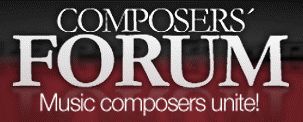In this track I applied my latest ideas of building dissonances to percussive instruments. This was interesting, because percussive instruments need more dissonances and more severe dissonances to begin to sound dissonating. So, in some places I could build very dissonating polyphony without creating chaos effect.
The first 12 measures of the track are created by choosing a short monophonic 4-note melody (all notes are eights) and modifying it several times. You can see that I use three melodies here: first in 6 starting measures, second in m7-m10, third in m11-m12. The third melody is built of 4th intervals and is then chromatically transposed with some modifications. When modifying the base melody I avoid changing its direction, while moving freely between keys and modes. I also avoid chromatic transposition, because it decreases amount of information and makes music feel more repetitive. In general, the final purpose was to make this part sound developing and not repetitive. When I heard this result, I stopped modifying notes.
After creating a monophonic melody this way I added intervals in the right hand. Most of the intervals are dissonating (2nd, 4th, tritone, 7th intervals). Each measure gets 2-3 intervals and a new rhythm is created by these intervals. This rhythm is highly syncopated and independent from bass line and main melody.
Then I add a bass line. Bass notes generally build consonant intervals with right hand notes that start at the same time. Bass line is repetitive, first moving around D and them moving to E.
Main melody rhythm is regular, while dissonant intervals and bass line form two independent irregular rhythms, creating a polyrhythm. When combined, all these techniques lead to a rhythmically repetitive but melodically and harmonically developing texture.
From m13 to m48 the same two-measure structure is repeated in the left and right hand with some elisions. Left hand is periodically transposed minor third below. Compared to the starting measures, this structure has little notes (which form mainly 2nd intervals) and more dense rhythms, created by: Ab note in the right hand, CD interval in the right hand, bass melody. These three rhythms form a percussive polyrhythm.
Beginning from m17, jug rhythm is added. m17-m18 all three drums are playing the same rhythm and then they diverge to create a more uniform 8th notes beat with some accents.
Solo uses harmonic minor intervals: H-W-H, W-H-WH, WH-H-W. This coupled with drums gives an oriental touch to the sound here. When solo is repeated, it is harmonized with additional voice, which creates many dissonant intervals.
Starting from m48 first part is repeated using new instruments. Bass line gets additional voice, which forms dissonant intervals with bass.
In m65-m74 some previous and new bass solos are played with dissonating intervals.
In m75-m86 exact retrograde of m1-m12 is played in the right hand, two pairs of new dissonant voices are played in plucked and bass. Interesting, that this place could sound a mess if played with non-percussion instruments.
In m87-m104 voice leading is used to move from dissonant harmonies to consonant, ending with absolute consonant (G in octaves). This is my extension of music resolution rules.
At the same time piano is playing minimal melody, while drums are repeating two-measure sparce rhythm, creating effect of space.
In this track I used three new piano libraries and one perccussion library.
- Felt piano - Piano with celeste pedal engaged (a layer of soft cloth or leather interposed between hammers and strings to give a sweet, singing and muted quality)
- Plucked piano - plucking grand piano strings
- Toy piano - small child's keyboard- Jugs - this is hitting water jugs with hands and sticks
Felt piano appeared to be extremely rich-sounding. One important thing is that it does not have loud and piercing sound at the higher end of the dynamics range, but it really doesn't have to. Using C+Co mics here.
Plucked piano is very reverberant even if you turn only close mic on. It is close to guitar, but sounds bigger and you cannot control articulations and sound. Using TAO mics here.
Tiny grand is one more pitched percussion from Embertone. It sounds realistic even when fully quantized, probably having different attacks in RR/VL samples. Very interesting instrument, but definitely having more percussive than melodic component - often you will not hear the difference between different intervals that you play with it.
Jug Drums are original and realistic, having an unexpectedly ethnic sound, which is not obvious from their look. Using standard mid+far+close(-5db) mics here.
All tracks except Plucked piano are passed through 2C Aether Medium hall.
I used about 8% Reaper timing humanization for most notes and 11% velocity humanization for drums.
When mastering I decreased 175hz (Q=0,47) and added lots of tape exciter above 809hz.
Libraries used:
Spitfire - Felt Piano (Piano)
Spitfire - Plucked Piano (Piano)
Embertone - Jug Drums (Percussion)
Embertone - Glockenpillar, Infinity Bells, Tiny Grand (Percussion) [Tiny Grand]
